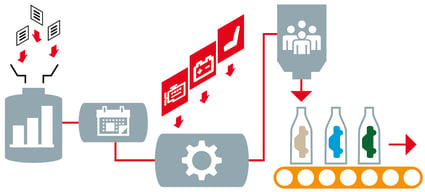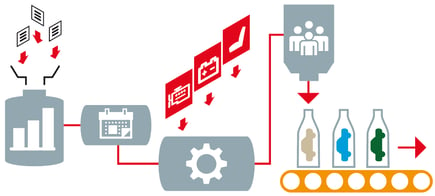What Is Reference Sequencing?
Brian Hoey - August 29, 2019

 Let’s say you’re a homebrewer, and you’ve just finished drafting your recipe for a dry-hopped pale ale that you plan to brew in the coming weeks. If you’re like most people, you go to a homebrew supply site and order your hops, malt, and yeast all at once, plus some clean bottles for your brew to wind up in. This strategy works perfectly well, but as you go, you find that it leaves something to be desired. While your beer is fermenting, you have a bunch of bottles taking up unnecessary space on your floor; and by the time you’re ready to dry-hop (which involves adding more hops during the fermentation period), the ones you bought from the homebrew site are a little stale.
Let’s say you’re a homebrewer, and you’ve just finished drafting your recipe for a dry-hopped pale ale that you plan to brew in the coming weeks. If you’re like most people, you go to a homebrew supply site and order your hops, malt, and yeast all at once, plus some clean bottles for your brew to wind up in. This strategy works perfectly well, but as you go, you find that it leaves something to be desired. While your beer is fermenting, you have a bunch of bottles taking up unnecessary space on your floor; and by the time you’re ready to dry-hop (which involves adding more hops during the fermentation period), the ones you bought from the homebrew site are a little stale.
Next time you’re brewing that same recipe, you change things up. You order your malt, yeast, and some of your hops right off the bat, but you wait to order the bottles and finishing hops until you actually need them. This saves you space during fermentation, and it ensures that you’re using the freshest possible ingredients at every stage of the process. The result? A better product created in a more convenient manner. Not only that, but you powered these improvements using an example of what’s known as reference sequencing.
Just in Time
It will probably not come as a surprise that reference sequencing is not natively a homebrewing concept, but rather a strategy that’s been adopted over the years by a number of manufacturing outfits. But what, exactly, is reference sequencing, and why should manufacturers know about it? Simply put, reference sequencing (also known as just in time sequencing) applies the principles of just in time delivery to your factory floor operations. Instead of making sure that a completed product reaches the customer’s door at the last possible minute in order to reduce buffer stock on their end (as in the case of just in time delivery), just in time sequencing involves making sure that any component part that goes into a final product doesn’t reach the production facility until just before it’s needed.
This strategy can be employed on the level of your existing inventory, by transporting raw materials from your stock to the production floor based on sequence—but it can also be applied on the level of supplier orders, i.e. rather than ordering the entire bill of materials for a particular product all at once you order by sequence in order to receive any given part only at the appropriate moment in the production process. If we think back to our homebrewing example, this is the equivalent of ordering bottles so that you’ll receive them at the exact moment you’re planning to use them; thus, if your plan is to bottle your beer after two weeks of fermentation, and the shipping time for the bottles is two days, you would order them on day 12. By the same token, if you were producing refrigerators, you would make sure that the plastic for the shelves and drawers was ordered at such a time as to ensure delivery only after the rest of the item had been put together.
Reducing Buffer, Maintaining Flexibility
Some of the benefits of adopting this approach in an industrial setting might be obvious: reduced buffer stock, for instance, leads to reduced storage needs and thus cost savings. Some of the larger operational implications, however, might not be so obvious on the surface. After all, it’s not only a case of reduced storage needs. On the contrary, this type of dynamic order management can build added flexibility and agility into your value chain in a way that’s truly value additive.
Imagine, for instance, that you’ve sketched out your production for the month, when all of a sudden a huge rush order from one of your most important clients comes in. In an environment with just in time sequencing, your production plans wouldn’t be dictated by the particular array of parts and raw materials that are already on hand. Instead of throwing your production flows into disarray and potential risking costly clean-up operations later, you simply adjust your incoming orders to reflect changing production plans. There’s no need for goods to pile up in your production area waiting to be incorporated into workflows—you simply reimagine your sequences and then make the necessary changes.
Challenges and Opportunities
Okay, we may have been a little bit glib above about how easy it is to maintain flexibility in a production facility that employs reference sequencing. Sure, if you need to adjust your plans on the fly (which, let’s be honest, you certainly will at some point), you’ll just have to alter your incoming raw material orders accordingly—but that can be easier said than done. In point of fact, the kind of agility we’re talking about—and, really, reference sequencing more broadly—requires an incredibly high degree of visibility across different manufacturing functions. Your production planners need to be operating within full visibility of order planners, who themselves need to be constantly connected to inventory managers. This is difficult, but not impossible.
Ultimately, for the reduction in buffer stock and increase in agility under discussion to be real possibilities, your business will need to prioritize an IT environment that offer high levels of data and planning visibility. This might be a single solution that connects every touch point on the value chain, or it might be a Postmodern ERP environment in which disparate IT solutions are all connected within a common system—but either way planners in different departments need to receive alerts instantaneously when plans are changed in a way that might affect them. By the same token, planners need to be able to visualize the effects of any proposed changes in real time. If you can make this a reality, you can turn a reference sequencing workflow into a major competitive advantage, one that reduces costs on your end while making life easier from an inventory management perspective. If not, you may encounter significant hurdles and disruptions as you seek to gain agility.
LATEST POSTS
- Understand Why Production Planning Needs Specialized Solutions
- Understand Circular Economy in The Manufacturing Industry
- How Can Industry 4.0 IT Integration Be Achieved Smoothly?
- The Significance of Order Sequencing in Discrete Manufacturing
- How to improve your Supply Chain Management: The Power of Control Towers



